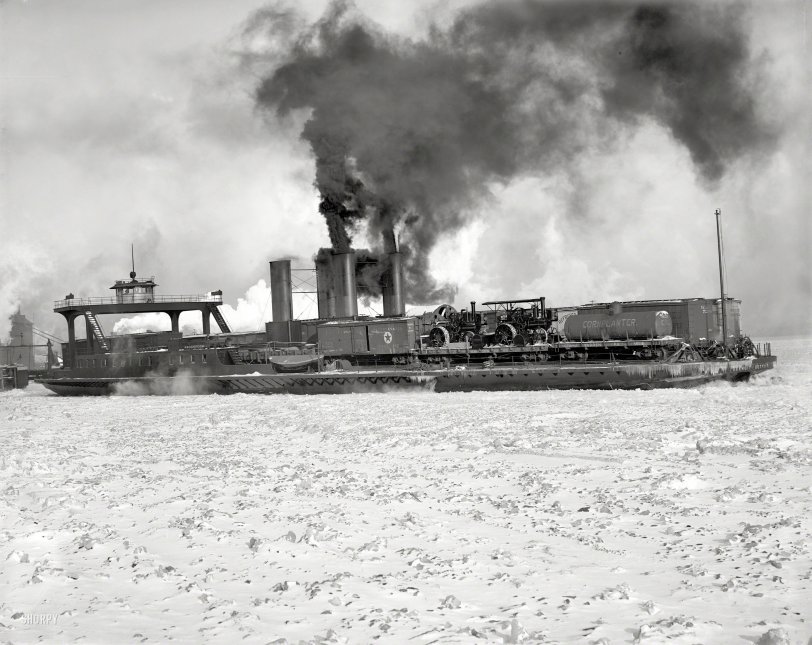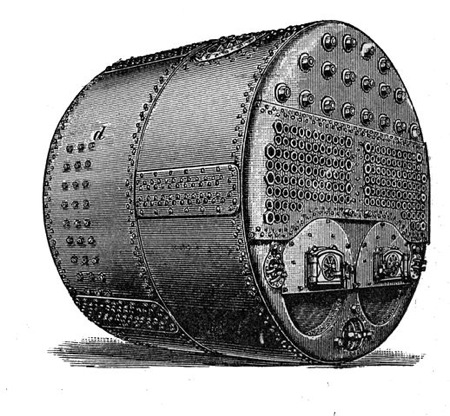


Framed or unframed, desk size to sofa size, printed by us in Arizona and Alabama since 2007. Explore now.
Shorpy is funded by you. Patreon contributors get an ad-free experience.
Learn more.

- Baldwin 62303
- Baldwin VO-1000
- Cold
- No expense spared
- Tough Guys
- Lost in Toyland
- And without gloves
- If I were a blindfolded time traveler
- Smoke Consumer Also Cooks
- Oh that stove!
- Possibly still there?
- What?!?
- $100 Reward
- Freeze Frame
- Texas Flyer wanted
- Just a Year Too Soon
- WWII -- Replacing men with women at the railroad crossing.
- Yes, Icing
- You kids drive me nuts!
- NOT An Easy Job
- I wonder
- Just add window boxes
- Icing Platform?
- Indiana Harbor Belt abides
- Freezing haze
- Corrections (for those who care)
- C&NW at Nelson
- Fallen Flags
- A dangerous job made worse
- Water Stop
Print Emporium
Smoke Monster: 1905

Circa 1905. "Transfer steamer Detroit of Detroit in the ice." 8x10 inch dry plate glass negative, Detroit Publishing Company. View full size.
The old boiler
is a Scotch marine boiler, which is a fire-tube type.

CTL = Cornplanters' Tank Line
A quick Google search turns up Cornplanters Tank Line reporting to many state railroad and corporation commissions. Since on this same boat, Merchants Despatch Transportation Co. uses the reporting marks of M.D.T.Co., I think that I've solved the CTL question.
Also of Interest
Behind the steam tractors sits a large water-tube boiler, presumably being shipped on a flat car. A better view of it is afforded in the closeup post of the tractors linked in a previous comment below.
Break The Ice
The trick of breaking ice with the Lake Michigan (railroad) car ferries was their relatively shallow draft and the wide flat bottom. The boat would be driven onto the ice sheet and break through. The weight of the boat plus 30 or so railroad cars was generaly effective. Ice on Lake Michigan will sometimes "windrow" and boats could become stuck, calling for another ferry to help them get loose.
Popular subject for Shorpy
Just from memory this must be the fifth or sixth photo (at least!) of the Detroit. I remember a previous ice breaking, box car loaded photo as an interesting winter time screen saver.
Nifty tank car
We must have the granddaddy of all modern double hulled tank cars here. The reporting marks, ‘CTL,’ are a mystery, though. Cannot find any reference to such marks from the early 1900s. The “Association of Transportation and Car Accounting Officers,” Published in 1914 by the Railway Equipment and Publication Company, does list reporting marks of ‘CRX,’ for cars owned by the Cornplanter Refining Company of Warren, Pa. The X in any reporting mark represents individual or other non railroad entity ownership. My guess: the CTL marking, whatever it meant, was in place prior to the Association of Transportation and Car Accounting Officers implementing the X rule.
The Detroit sucked
Their hulls were reinforced and many had prop guards of various sorts. The Detroit was considered by many to be the ultimate. She had four screws, two aft and two forward and they often ran all of them at once in ice. The forward screws would suck water out from under the ice as she headed into it, which would cause the resultant "shelf" to collapse into the void created below and break up under it's own weight without having to resort to ramming. The props on many of the car transfer river ferries were massive cast iron things that could grind up ice, rather than the more delicate (and efficient) marine bronze shapes found on some of their cross lake counterparts.
Special ice breakers
The Great Lakes railroad train car ferries are also "special ice breakers," and some have even been rented out for that purpose. Some of the Lake Michigan boats, especially, even though single ended, had bow propellers, which also helped break the ice in front of them.
Ice
Can some great lakers enlighten me as to how these steamers could navigate in thick ice without ruining their hulls? I thought even nowadays special ice breakers were needed to break up the ice around harbors, etc.
Buffalo-Pitts Tractors
They're both Buffalo-Pitts tractors. A close up of this steamer was posted as https://www.shorpy.com/node/10517.
Brand new tractors
I love the brand new steam tractors out for delivery...can anyone see the make?
























On Shorpy:
Today’s Top 5